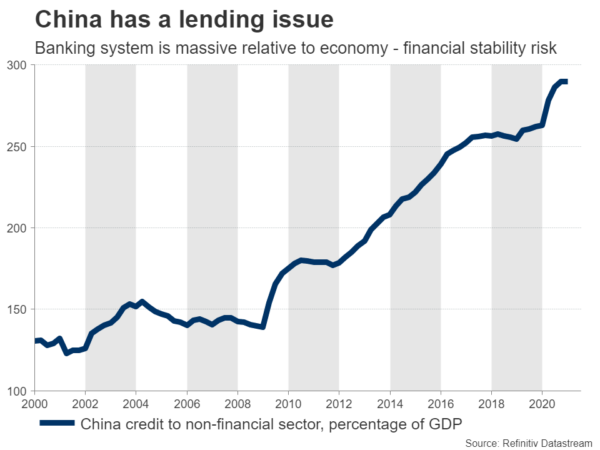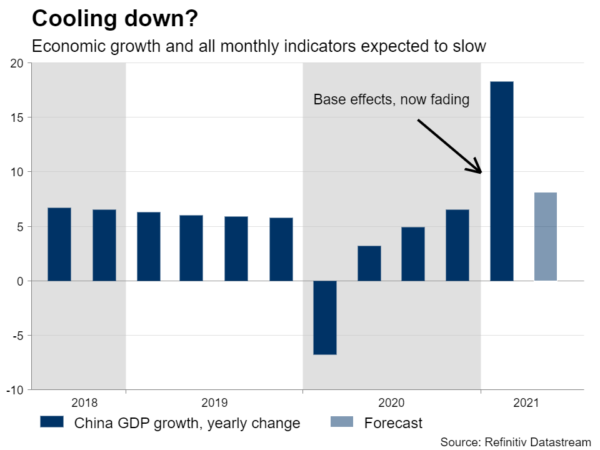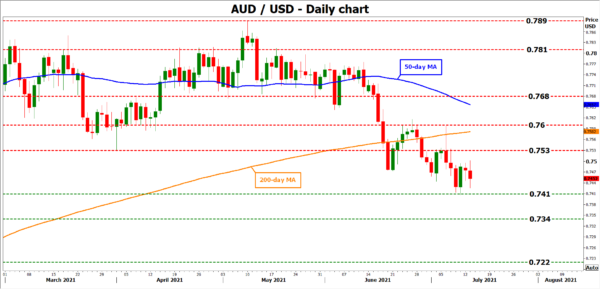Economic growth numbers out of China will hit the markets at 02:00 GMT Thursday. The world’s second-largest economy seems to be losing momentum and Chinese authorities have responded by adding more liquidity to the financial system, which is a risky move. Besides the yuan, the upcoming data could also impact stock markets and the Australian dollar.
Gamble
The Chinese economy seems to be losing steam. Business surveys like the PMIs declined sharply in June, signalling a slowdown in growth as new coronavirus outbreaks forced manufacturing hubs in southern China to go back into lockdown and supply chain problems continued to rage.
Last week, the central bank stepped in to address this, cutting its reserve requirement ratio for commercial banks. The move was designed to free up capital that banks can then lend out to the real economy, ultimately boosting growth. But this is a risky tactic.
China has a huge problem with private debt and enormous leverage in the banking sector, which regulators have tried to suppress for years. Indebted businesses and a massive banking system are a recipe for a financial crisis. When you cut reserve requirements, you incentivize even more lending, adding more fuel to this fire.
The fact that Chinese authorities were willing to take this gamble shows just how concerned they are about an economic slowdown, prioritizing that over financial stability.
Peak growth?
The upcoming dataset could confirm this narrative. GDP growth is expected to have slowed to 8.1% in the second quarter, from 18.3% previously in yearly terms. To be fair, much of this slowdown is mechanical – it comes down to base effects from last year’s slump fading out of the yearly calculation.
Still, it’s a bad look as it suggests that growth might have peaked already. Retail sales, industrial production, and fixed asset investment are all expected to have slowed in June as well.
Aussie in the spotlight
Turning to the market reaction, besides the Chinese yuan, this data will also impact the Australian dollar and global stock markets. China is Australia’s closest trading partner, so the trend in Chinese data is also crucial for Australian ones.
In fact, the aussie is often viewed as a liquid proxy for ‘China plays’. Speculators favor it over the yuan for betting on the Chinese economy, as shorting the yuan for example implies the added risk of being caught on the wrong side of FX intervention by the nation’s authorities.
If the recent cut in reserve ratios by the Chinese central bank really foreshadowed a disappointment in GDP growth this week, then the aussie could take another hit. Taking a technical look at aussie/dollar, initial support to any declines could come from the 0.7410 zone, a break of which would turn the focus towards 0.7340.
On the other hand, a positive surprise in GDP could see the pair push higher to challenge the 0.7530 region. If the bulls manage to pierce above it, their next target could be the 0.7600 handle.
All told, the latest moves by Chinese authorities are a negative signal about the economy’s fortunes and also amplify financial stability risks. A persistent slowdown in China could keep the aussie under pressure, especially considering that the Reserve Bank of Australia could be among the last central banks to raise rates this cycle.


















